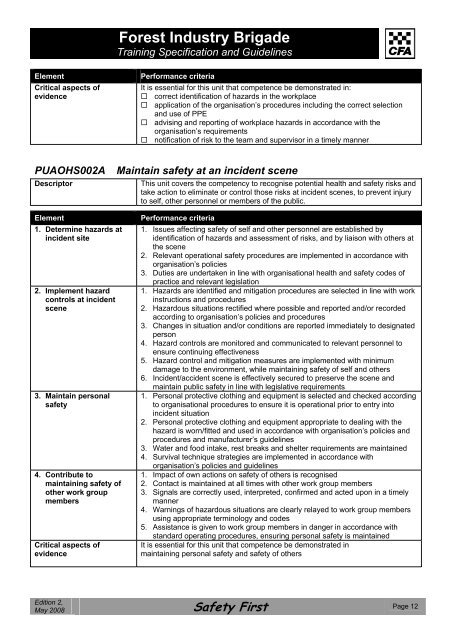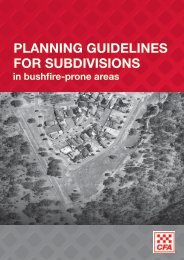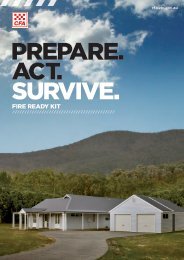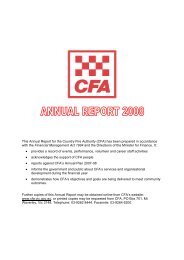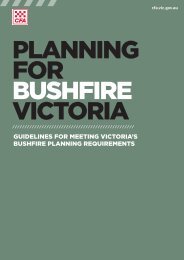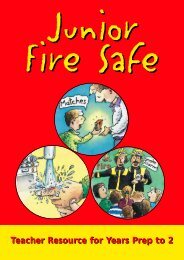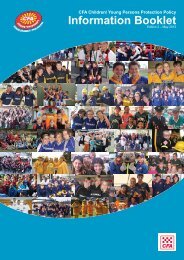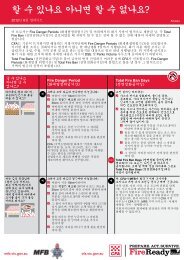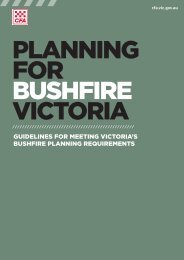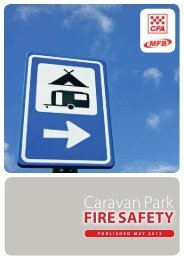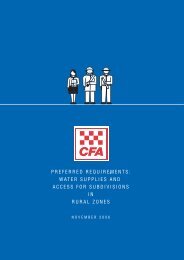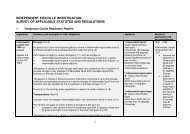Training Specifications and Guidelines - Country Fire Authority
Training Specifications and Guidelines - Country Fire Authority
Training Specifications and Guidelines - Country Fire Authority
You also want an ePaper? Increase the reach of your titles
YUMPU automatically turns print PDFs into web optimized ePapers that Google loves.
Forest Industry Brigade<br />
<strong>Training</strong> Specification <strong>and</strong> <strong>Guidelines</strong><br />
Element<br />
Critical aspects of<br />
evidence<br />
Performance criteria<br />
It is essential for this unit that competence be demonstrated in:<br />
correct identification of hazards in the workplace<br />
application of the organisation’s procedures including the correct selection<br />
<strong>and</strong> use of PPE<br />
advising <strong>and</strong> reporting of workplace hazards in accordance with the<br />
organisation’s requirements<br />
notification of risk to the team <strong>and</strong> supervisor in a timely manner<br />
PUAOHS002A<br />
Descriptor<br />
Maintain safety at an incident scene<br />
This unit covers the competency to recognise potential health <strong>and</strong> safety risks <strong>and</strong><br />
take action to eliminate or control those risks at incident scenes, to prevent injury<br />
to self, other personnel or members of the public.<br />
Element<br />
1. Determine hazards at<br />
incident site<br />
2. Implement hazard<br />
controls at incident<br />
scene<br />
3. Maintain personal<br />
safety<br />
4. Contribute to<br />
maintaining safety of<br />
other work group<br />
members<br />
Critical aspects of<br />
evidence<br />
Performance criteria<br />
1. Issues affecting safety of self <strong>and</strong> other personnel are established by<br />
identification of hazards <strong>and</strong> assessment of risks, <strong>and</strong> by liaison with others at<br />
the scene<br />
2. Relevant operational safety procedures are implemented in accordance with<br />
organisation’s policies<br />
3. Duties are undertaken in line with organisational health <strong>and</strong> safety codes of<br />
practice <strong>and</strong> relevant legislation<br />
1. Hazards are identified <strong>and</strong> mitigation procedures are selected in line with work<br />
instructions <strong>and</strong> procedures<br />
2. Hazardous situations rectified where possible <strong>and</strong> reported <strong>and</strong>/or recorded<br />
according to organisation’s policies <strong>and</strong> procedures<br />
3. Changes in situation <strong>and</strong>/or conditions are reported immediately to designated<br />
person<br />
4. Hazard controls are monitored <strong>and</strong> communicated to relevant personnel to<br />
ensure continuing effectiveness<br />
5. Hazard control <strong>and</strong> mitigation measures are implemented with minimum<br />
damage to the environment, while maintaining safety of self <strong>and</strong> others<br />
6. Incident/accident scene is effectively secured to preserve the scene <strong>and</strong><br />
maintain public safety in line with legislative requirements<br />
1. Personal protective clothing <strong>and</strong> equipment is selected <strong>and</strong> checked according<br />
to organisational procedures to ensure it is operational prior to entry into<br />
incident situation<br />
2. Personal protective clothing <strong>and</strong> equipment appropriate to dealing with the<br />
hazard is worn/fitted <strong>and</strong> used in accordance with organisation’s policies <strong>and</strong><br />
procedures <strong>and</strong> manufacturer’s guidelines<br />
3. Water <strong>and</strong> food intake, rest breaks <strong>and</strong> shelter requirements are maintained<br />
4. Survival technique strategies are implemented in accordance with<br />
organisation’s policies <strong>and</strong> guidelines<br />
1. Impact of own actions on safety of others is recognised<br />
2. Contact is maintained at all times with other work group members<br />
3. Signals are correctly used, interpreted, confirmed <strong>and</strong> acted upon in a timely<br />
manner<br />
4. Warnings of hazardous situations are clearly relayed to work group members<br />
using appropriate terminology <strong>and</strong> codes<br />
5. Assistance is given to work group members in danger in accordance with<br />
st<strong>and</strong>ard operating procedures, ensuring personal safety is maintained<br />
It is essential for this unit that competence be demonstrated in<br />
maintaining personal safety <strong>and</strong> safety of others<br />
Edition 2,<br />
May 2008 Safety First Page 12


